An Introduction to the Spicy, Funky World of Korean Soups and Stews
Get to know the backbone of the Korean diet.
Korean barbecue may get all the attention, but soups and stews really make up the backbone of the Korean diet. Historically, beef was a scarce commodity, so grilled galbi and bulgogi were reserved for special occasions. But no matter what else is on the dinner (or breakfast) table, there's always soup or stew, sometimes serving as a palate cleanser between bites of heavier dishes.
Stews (you'll recognize them by the suffix "-jjigae") are generally cooked quickly, bringing together a panoply of ingredients, whereas Korean soups (with the suffix "-guk" or "-tang") are brothy, spartan, and cooked for hours—or even days. Both are meant to be eaten with rice on the side. Simple soups (guks) are often offered alongside other main dishes at restaurants, usually for no charge. More complicated and hearty stews (jjigaes), identified by the use of an earthenware bowl (ddookbaegi), are sometimes shared communally.
""Many Korean soups have specific functions.""
Many Korean soups have specific functions. Is the ground spinning because you drank too much last night? Try haejang guk, made with bean sprouts, radishes, and earthy cubes of ox blood. Feeling sniffly, like you're about to get that cold that everyone gets in the middle of a hot summer? Kill two birds with one stone with a bowl of steaming samgyetang, simmered with jujubes, ginger, and garlic—meant to prevent illness and to promote sweating to cool the body. If you want to properly celebrate the New Year, ddukguk is mandatory, full of oval slices of rice cake (dduk) and soft boiled dumplings (mandoo). If you've just had a baby, focus on savory miyeokguk, made with soothing, vitamin-rich seaweed (miyeok), to regain nutrients lost during delivery. (Miyeokguk also appears on birthdays, so that children can remember their mothers' hardship.)
Instead of relying on pure salt, cooks season these dishes with soy sauce, salted baby shrimp (saewoojut), fermented miso (daenjang), dried anchovies (myulchee), and fish sauce. Spicy heat comes in from hot pepper flakes (gochugaru), fresh hot peppers (such as jalapeños), dried hot red peppers, or gochujang, a richly spicy, thick, and slightly sweet red pepper paste. Because gochujang also has fermented soybeans, it's a little bit funky, but roundly savory in flavor. The broths are based on beef or chicken, dried anchovy, kombu, or seafood (but water will usually do in a pinch). Dashi powder, which adds flavor by the tablespoon to boiling water or broths, comes in anchovy, beef, or seafood flavor.
Feel overwhelmed when you're faced with the menu at your local Korean restaurant? Let's get to know some of the most beloved Korean soups and stews.
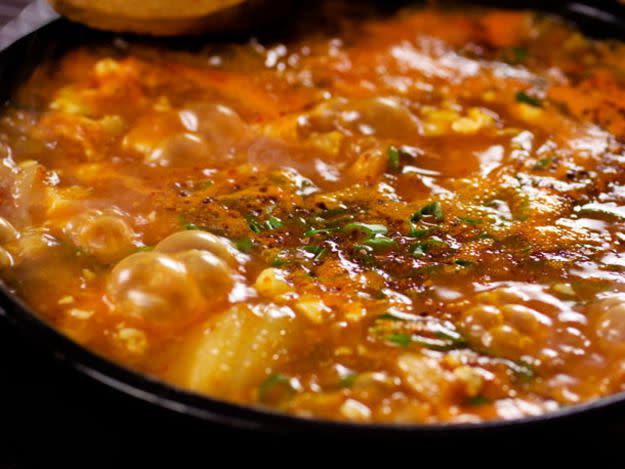
Jjigae (Stew)
Soondubu Jjigae
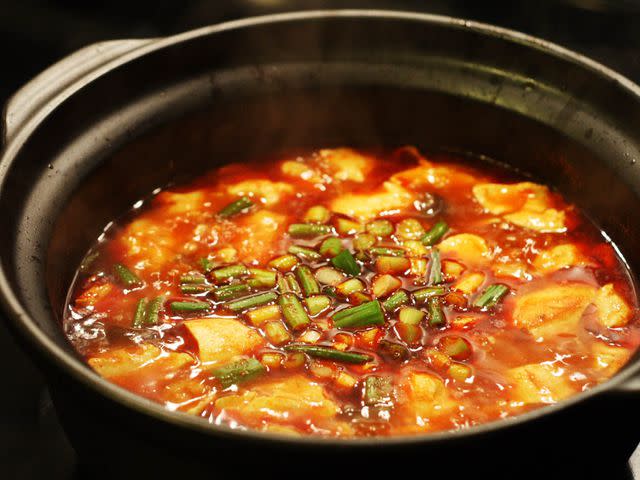
Jean-Philippe Daigle / Flickr
What's in it: Dubu (soft tofu), beef, seafood (or a combination), and vegetables in a spicy broth flavored by gochugaru and soy sauce.
Soondubu jjigae—a hot tofu stew that's fearsome to behold, bubbling angrily and tinged red with chiles—is so popular that some entire restaurants are focused on perfecting it. It's made by combining handfuls of Korean hot pepper flakes (gochugaru), soy sauce, and either beef, seafood, or a combination in a clay pot with vegetables and either a seafood or beef-based broth. Giant spoonfuls of custardy soft tofu (dubu) are added gently near the end of the cooking process. At many traditional spots, you will be given a raw egg on the side, which should be added while the broth is still hot. Some restaurants also add noodles and dumplings. The flavors are spicy and red pepper-hot up front, and a slow burn near the end, tempered by the creamy tofu and the rich egg yolk.
If you're lucky, the restaurant will give you a clay or metal pot of sizzling rice alongside your soondubu jjigae. Scoop out just the middle and put to the side, whereupon a waiter will come by and fill the rice-edged pot with roasted barley tea (boricha). Leave this be, and at the end of the meal, stir all the burnt, crusty edges of the rice (similar to the edges left by a good dolsot bibimbap) together with the hot tea, and you have a nutty, warming toasted rice porridge (nooroongjie) to help settle your stomach.
Tip
If you're lucky, the restaurant will give you a clay or metal pot of sizzling rice alongside your soondubu jjigae. Scoop out just the middle and put to the side, whereupon a waiter will come by and fill the rice-edged pot with roasted barley tea (boricha). Leave this be, and at the end of the meal, stir all the burnt, crusty edges of the rice (similar to the edges left by a good dolsot bibimbap) together with the hot tea, and you have a nutty, warming toasted rice porridge (nooroongjie) to help settle your stomach.
Kimchi Jjigae
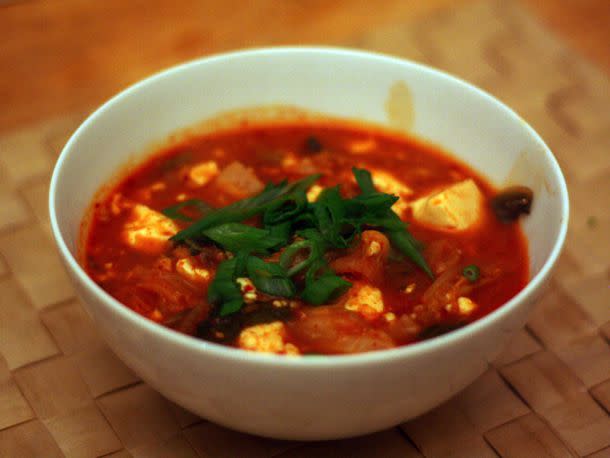
Serious Eats / Nick Kindelsperger
What's in it: Kimchi mixed with pork or beef in broth.
Kimchi jjigae is like making lemonade out of really old lemons—the more fermented and funky the kimchi, the better the stew. To make kimchi jjigae, the spicy kimchi is mixed with pork or beef and a bit of water or broth in a clay or metal pot, and left to simmer for at least a half hour, or until the cabbage is soft and almost melting, and its inimitable aroma drifts into your hair, clothes, and the pores of your skin. If the kimchi is too sour, you can add a spoonful of gochujang or a little bit of sugar. The stew is served steaming hot, and the flavor is in-your-face, red pepper-flaked spicy with a fermented vegetal twang, a little fat from the meat, and fabulously piquant. This is one that you'll definitely want with white rice on the side (not to mention lots and lots of water).
Got leftover kimchi jjigae? Take advantage of the softened texture of long-cooked kimchi and simmer your leftovers on the stove with some sesame oil and a little brown sugar for about fifteen minutes. The result is kimchi jjigae's kinder, more elegant, but still totally funky sister—silky and slightly sweet, rich and spicy, and excellent with white rice.
Tip
Got leftover kimchi jjigae? Take advantage of the softened texture of long-cooked kimchi and simmer your leftovers on the stove with some sesame oil and a little brown sugar for about fifteen minutes. The result is kimchi jjigae's kinder, more elegant, but still totally funky sister—silky and slightly sweet, rich and spicy, and excellent with white rice.
Daenjang Jjigae
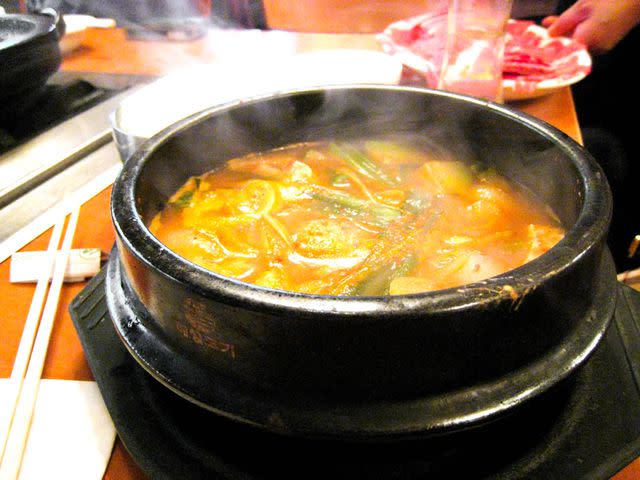
Serious Eats / Sarah Song
What's in it: Vegetables, onion, potatoes, tofu, and meat in a broth flavored by daenjang (Korean fermented miso paste).
Daenjang jjigae is a simple savory stew, a weekday standby in Korean homes (in fact, it was the first stew my mother taught me to make.) It's something of a whatever's-in-the-fridge-and-pantry concoction, made with daenjang—a fermented miso paste that many Korean cooks have handy in the fridge, plus whatever potato or onion are in the pantry, and any vegetables (such as zucchini and hot peppers) that might be laying around. Daenjang comes in a range of stages of fermentation: The darker the paste, the stronger and earthier the flavor. Unlike Japenese-style miso, which is smooth and delicate, daenjang is country-style, with chunks of fermented soybeans (which usually get sifted out during the cooking process), and ultimately, richer and deeper in flavor than your typical Japanese miso soup. The base of daenjang jjigae is broth or water with instant dashi, dried anchovies, or meat for flavor, simmered with veggies and then the daenjang and tofu, with green onions added as a final touch.
Kongbiji Jjigae
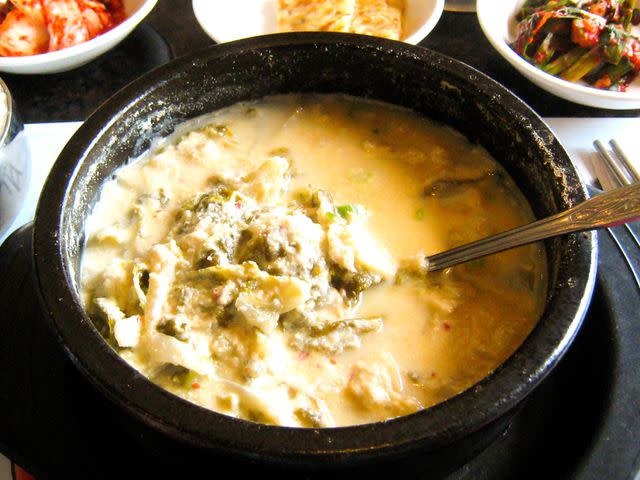
Serious Eats / Sarah Song
What's in it: Ground up soybeans or soy pulp in broth with pork ribs, garlic, and sometimes kimchi.
Kongbiji is perhaps an acquired texture and taste, but once I started eating it, I was hooked. Made of either ground-up soybeans or soy pulp (the dregs after making tofu), homemade kongbiji jjigae is a labor of love, since the dried soybeans must be soaked overnight, and then puréed in a blender with water. The ground soybeans are added to a simmering stew of pork ribs, garlic, broth (usually anchovy or instant dashi), and sometimes kimchi. The soybean mixture bubbles up like crazy when it gets hot. Green onions are added for a little bitter crunch at the end. Kongbiji jjigae is sometimes served with extra kimchi and a sauce of soy sauce, hot pepper flakes, toasted sesame seeds, garlic, rice vinegar, and sesame oil.
Ahl Jjigae
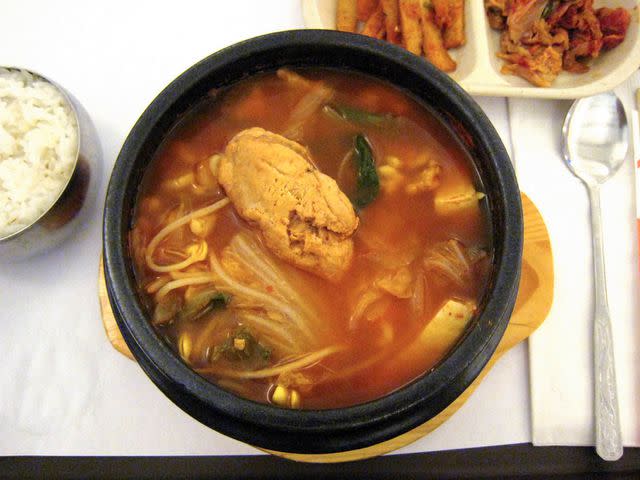
Serious Eats / Sarah Song
What's in it: Seasoned pollack roe simmered with broth, tofu, and red pepper flakes.
Ahl is seasoned pollack roe, often served as a salty and sea-flavored banchan, or with rice, garnished with a little sesame oil and toasted sesame seeds. To make this stew, the seasoned roe is simmered with broth, tofu, and red pepper flakes. The ahl is pretty salty on its own, so you don't need a ton of seasoning, but the stew balances the unique seafood flavor with spice from the red pepper and creaminess from the tofu. The cooking process turns the tiny eggs from a little bit juicy to firm, and squeaky—it's pretty fun to eat.
Budae Jjigae
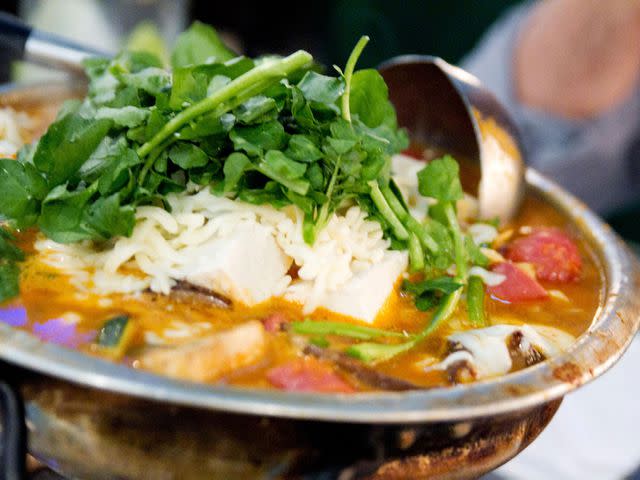
Serious Eats / Robyn Lee
What's in it: A variety of ingredients, from Spam, bacon, and Vienna sausages, to ramen noodles, tofu, and rice cakes, in a spicy broth made from kimchi, gochugaru, and gochujang.
Budae jjigae literally translates to army stew. During the US occupation of Korea during the Korean War, locals were introduced to such American delicacies as Spam and hot dogs, and ended up making this bizarre and utterly tasty mishmash of Korean and American foods, starring random meats backed up by kimchi, ramen noodles, tofu, and more. It gets its spice from the kimchi, plus both gochugaru and gochujang. (The thinking goes: The spicier the better, because then you get to drink more beer.)
The basic principle behind budae jjigae is sort of a pop-and-drop method (that is: popping cans and dumping the contents in your stew), and it can have all sorts of crazy ingredients, including cans of baked beans, Vienna sausages, Kraft cheese slices, rice cakes, bacon—basically, whatever you're able to rustle up. No need to get fancy with the broth or with your manners—this stew is usually eaten out of a big communal bowl. It's a cacophony of spice, meat, and umami. Have another beer.
Guk (Soup)
Dduk Guk
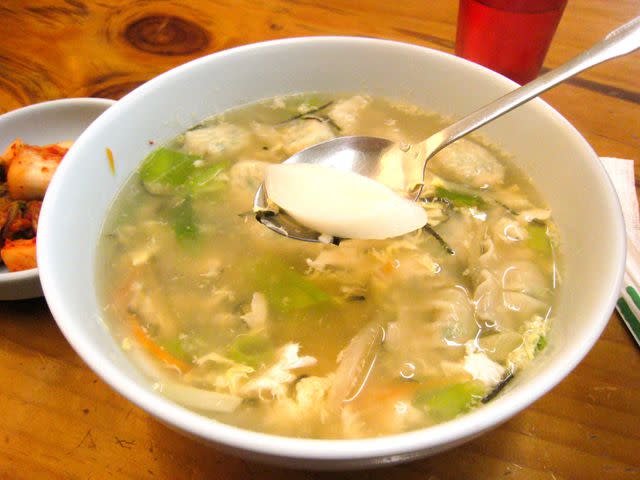
Serious Eats / Sarah Song
What's in it: Dduk (rice cakes) in a beef broth, garnished with sliced fried eggs, toasted seaweed, green onions, and shredded beef.
Dduk are rice cakes, and for this soup they are sliced into ovals, which some say are meant to represent coins for prosperity. You can make the dduk yourself with rice flour, sesame oil, and a mortar and pestle (though that requires giving up hours of time you'd probably rather be spending watching Netflix.) It's fine to buy it like most people do, fresh or frozen, from the Korean grocery store.
The key to a good dduk guk is the broth. The beef broth should be very clear, fragrant with meat but with just the barest hint of oil. Cooking the rice cakes in the broth leaves them soft to the tooth. The dish is garnished with thinly sliced fried egg, toasted seaweed, and chopped green onion, and sometimes an addition of shredded beef seasoned with soy sauce, rice wine, and sesame oil.
Miyeok guk
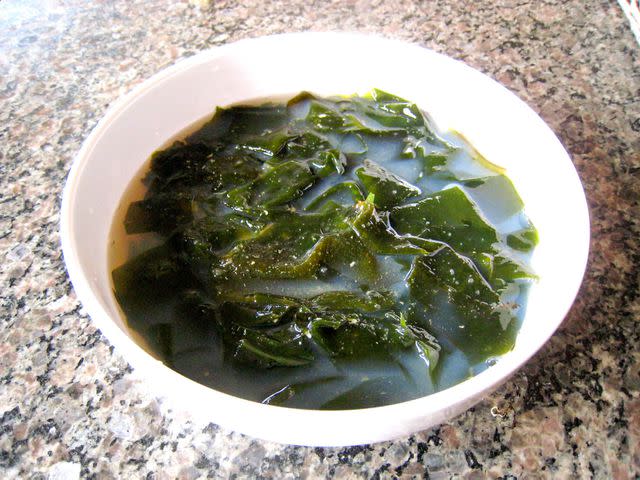
Serious Eats / Sarah Song
What's in it: Miyeok (dried seaweed) in a broth made from anchovies, seafood or sometimes beef.
This traditional birthday soup gets its delicate flavor and fragrant aroma from the miyeok, or dried seaweed. The seaweed is steeped in water until pliable, cut into pieces with scissors, and simmered with dried anchovies or other seafood (such as clams), or sometimes beef, plus a little bit of sesame oil. Unlike many Korean soups, miyeok guk has little garlic in it, since the potent allium can overpower the light flavor of the miyeok. The seaweed is delightfully slippery, tender, and has the faintest flavor of the ocean.
Kongnamul Guk
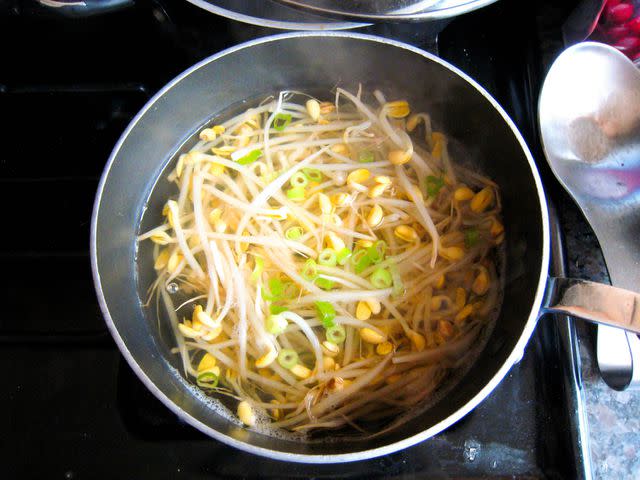
Serious Eats / Sarah Song
What's in it: Kongnamul (yellow soybean sprouts) in an anchovy or beef broth, with onion and garlic.
Kongnamul guk is a humble and simply flavored soup, featuring kongnamul, or yellow soybean sprouts. It's a great palate cleanser between bites of other dishes. The soybean sprouts have long, crunchy stems with yellow beans at the tip. Many people eat kongnamul in banchan form, either raw, blanched, or sautéed, but this soup makes the most of its mild vegetal flavor. Simply boiled with anchovy or beef, onion, and garlic, the kongnamul's yellow heads remain firm, while the stems become translucent and plump.
Haejang Guk
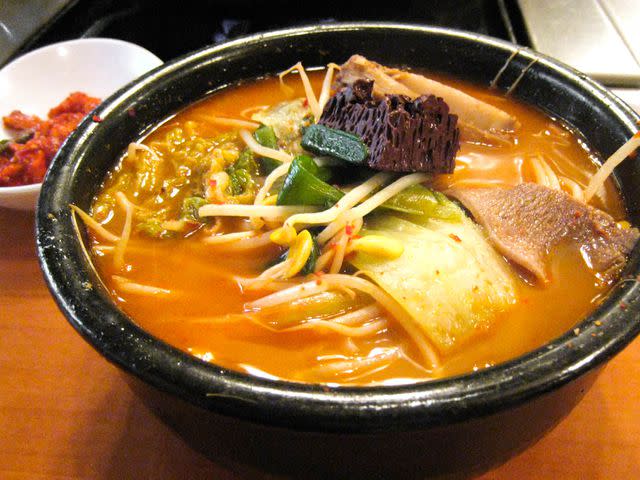
Serious Eats / Sarah Song
What's in it: Congealed ox blood, pork spine or tripe in a daenjang-based broth with beef and vegetables.
The unabashedly hearty haejang guk (or 'hangover soup') has some pretty outlandish ingredients, namely, congealed ox blood and sometimes pork spine or tripe. The congealed ox blood is cut into cubes or collected into chunks, and simmered in a daenjang-based broth with beef and vegetables, often including soybean sprouts. The congealed blood tastes pretty much like what you'd expect—iron-rich, earthy, a little meaty—with a texture thicker than custard or jello, and more like firm tofu. Give it a try the next time you're feeling haggard after a night of drinking.
Moo Guk

Serious Eats / Sarah Song
What's in it: Daikon in a beef or anchovy-based broth.
Moo guk is a beef or anchovy broth-based soup that features the unpretentious daikon (moo). Daikon turns sweet and tender when sliced into thin squares and boiled in broth. The steaming broth is clean and just barely tastes of radish, and the slivers of moo have just enough texture to keep the soup from being boring. Enjoy it with spicy banchan and some rice on the side.
Tang/Jang (Soups and Stew Made With Meat)
Gamjatang
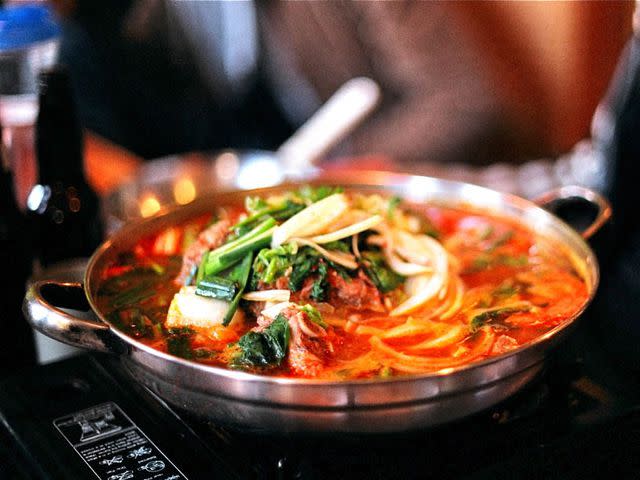
Pam Lau / Flickr
What's in it: Pork and (sometimes) potatoes, as well as Napa cabbage, soybean sprouts, and mushroom in a spicy pork broth with a slightly bitter, herbaceous note from perilla seed powder or fresh perilla leaves.
So, gamja means potato, and tang means soup, so you'd think this soup always had potatoes, right? But actually, gamjatang always has pork, and only sometimes has potatoes. It's a spicy, rib-sticking, robustly flavored soup featuring pork on the bone: usually ribs, neck or spine, that's soaked in water for hours before simmering. Daenjang and gochujang offer salt and spice, and the soup is filled out with Napa cabbage, soybean sprouts, and mushrooms. (Plus sometimes potatoes.) The soup gets a slightly bitter, herbaceous flavor from the addition of perilla seed powder or sliced fresh perilla leaves.
Maeuntang
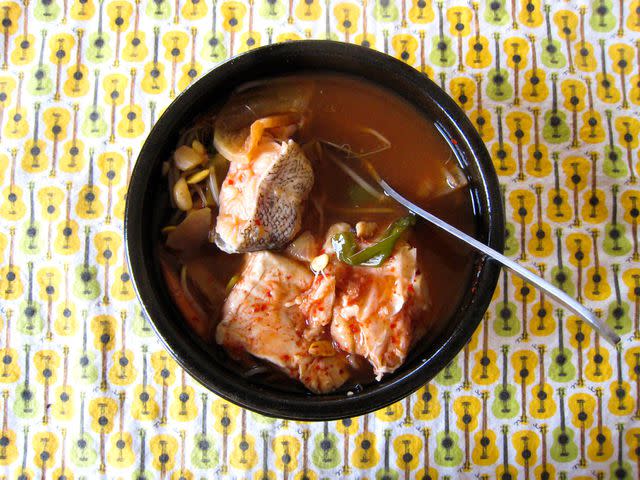
Serious Eats / Sarah Song
What's in it: Fish in a spicy seafood or kelp-based broth, flavored with gochugaru and gochujang. Vegetables like mushrooms, daikon, ssukgat, and onions are added near the end.
The name literally translates to 'spicy soup,' so you probably won't be surprised that this soup's main flavoring comes from gochugaru and gochujang. The other key ingredient: fish such as red snapper, codfish, carp, trout, or sea bass. If you go to an old-school Korean joint, they will even let you pick your favorite fish from the tank. Giant chunks of fish (with bones intact), sometimes combined with other seafood, are boiled in a seafood or kelp-based broth along with the gochugaru and gochujang. Mushrooms, daikon, ssukgat (garland chrysanthemum, a bitter green), and onions are added near the end. It's crazy spicy and a little sloppy to eat: Everyone will be sweaty and messy with fish bones by the end of the meal (and if that image doesn't appeal to you, I don't know what will).
Seolleongtang

Serious Eats / Farley Elliot
What's in it: Brisket, shank, tongue, tendon, tripe, or a combination, simmered in a beef broth with glass noodles.
Instead of chicken soup, seolleongtang is what I crave when I'm sick. The broth is made by simmering beef bones for an entire day, until all of the marrow has been extracted; the result is a cloudy, snowy white broth that somehow manages to be thick and delicate at the same time. (Seek a restaurant serving only seolleongtang—these specialists tend to really know what they're doing.) It's served with translucent glass noodles and additional beef: often brisket, shank, tongue, tendon, tripe, or a combination, simmered in the pot with the bones and then removed to prevent overcooking. Seolleongtang is all about comfort: gentle on the stomach, soothing to the soul.
Tip
Seek a restaurant serving only seolleongtang—these specialists tend to really know what they're doing.
Galbitang

Serious Eats / Sarah Song
What's in it: Short rib broth, daikon, glass noodles.
Korean barbecue fans know that galbi means short ribs, and if you love 'em, this soup's for you. It's brothy but very filling, starring meaty garlic-seasoned galbi, cooked until soft enough to eat with a spoon. Making this soup requires a lot of rinsing and straining, since short ribs are pretty fatty, but the result is a clear broth, with some pieces of tender daikon, glass noodles, and massive chunks of tender short rib.
Ggorigomtang
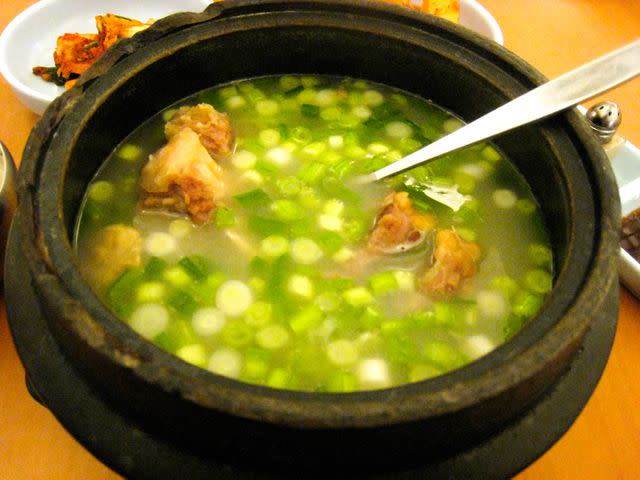
Serious Eats / Sarah Song
What's in it: Oxtail broth, garnished with green onions.
Essentially, Ggorigomtang is like galbitang, but with two- or three-inch pieces of oxtail instead of galbi. The process is time-consuming: the oxtails are soaked in water, and then boiled, skimmed, boiled, chilled, skimmed, boiled (you get the picture) for hours. You're left with a beautiful clear broth that's packed with intense beefy flavor. The oxtails end up supple and tender, just barely attached to the bone. All that's left to add is a handful of chopped green onions and a little salt and pepper.
Samgyetang
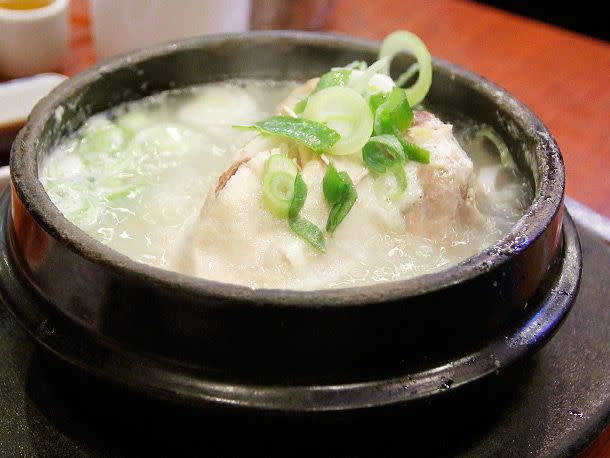
Serious Eats / J. Kenji Lopez-Alt
What's in it: Cornish hens or whole young chickens are stuffed with a variety of nutrient-filled ingredients like ginseng, jujubes, and glutinous rice.
Samgyetang is an old-fashioned, hearty soup, served during hot weather to promote sweating, which helps cool the body. It's a treasure trove of nutrient-filled, sickness-thwarting ingredients like ginger, ginseng, dried jujubes (Korean dates), and garlic. Cornish game hens or whole young chickens are stuffed with a mixture of glutinous rice along with the ginger, garlic, ginseng, and jujubes, and simmered until tender. Eating this dish requires a bit of skill, but digging through the broth for the tender rice-stuffed birds is worth the effort.
Yukgaejang
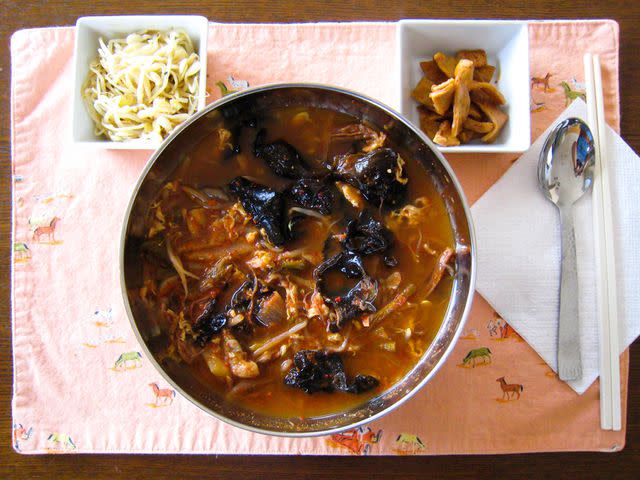
Serious Eats / Sarah Song
What's in it: A variety of vegetables, shredded brisket, and chile oil.
This rich and spicy winter soup will make chile lovers cry hot tears of joy. It's deeply flavored and bright red in color, made hearty with plenty of shredded brisket. The fragrant soup usually has a slick of shiny red chile oil on top of the surface, underneath which lurks all sorts of vegetables, including daikon, mushrooms, wild fiddlehead ferns, and lots of green onions and leeks.
October 2014
Read the original article on Serious Eats.

